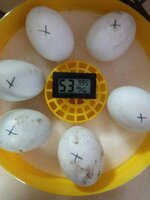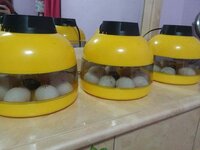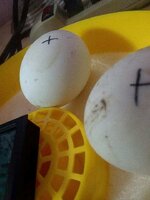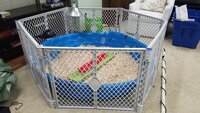I've gotten tired of our pond (Well, NOT ours... city owned... and neglected) looking worse year after year. At our own expense we've put in bubblers, a seemingly worthless amount of chemicals, and stocked it with fish two different years. But also being a run-off for residential properties in a middle class area and surrounded by trees, it's being fed fertilizer and leaves galore. I'm fully anticipating the duckweed to completely cover the .85 acres of water this year... or maybe not!
I had this epiphany that what better to clear duckweed than ducks themselves! Sure we get the occasional migrating Canadian geese, Mallards, and Woodland ducks, but they don't stay long enough to help out in the heat of summer. So when the law was passed allowing backyard fowl within city limits, I jumped on the opportunity and bought Pekin duck eggs to incubate.
I decided since I'm stuck at home schooling my grandkids because of schools closed and being quarantined due to the Coronavirus, we are doing our own science project. "How many ducks are you hoping to hatch?" the seller asked. We told him no more than 5 and he suggested we buy 2 dozen since he had only a handful of drakes to several dozen hens. Well, guess what? Twenty-two eggs... yes, 22 out of 24... were fertilized and are now growing in the incubators of our "surrogate mom" (our son's girlfriend). I immediately called the hobby farm where we buy our fresh chicken eggs from to see if they'd be interested in some ducks and they said, "We'd be delighted!" Phew!! was all I could say.
Then the research began on incubating, hatching, raising, and sheltering Pekin ducks. (I'm sure there's more to know, but that's why I'm here!) Some stuff fell right into place. "Selene" (son's girlfriend - name changed for identity protection) had incubators from her senior class project of raising Quail. We also have as a part of our family what will be their "nanny"; Apollo - our white and blue merle Border Collie. With a natural pond in our backyard and a perfect spot for a duck yard, we are perfect candidates for giving ducks a good home. Being recycler's at heart, the search began for materials to build a duck house, a pond raft, and a yard enclosure for our soon-to-be flock.
The plan is to enclose the 25' square space where our kid's trampoline is located. I HATE crawling under it to get the weeds, and the ducks will surely be happy to help me! We found a place that has BEAUTIFUL uniform pallets that we will use to make a fenced yard, the duck house and a raft for the pond. A few of our neighbors contributed materials like chicken wire, galvanized metal sheets and plywood. We found another company that has large pieces of dense styrofoam blocks that were used in packing. We will coat these with marine paint to float a pallet as a raft on the pond. I have a large octagonal play yard for my grandkids that we'll use as a brooding pen. Apollo already has a large kiddie pool that he shares with grandkids, so I'm sure he'll be happy to share it with his flock as well!
Now we just need the basics... feeders, warmers, bedding... oh yeah!! Knowledge and experience!! (I'm sure there's more I'm missing.) I placed an order for starter feed. I made sure it had the protein and niacin requirements ducklings need. I also ordered the book "The Ultimate Pet Duck Guidebook: All the things you need to know before bringing home your feathered friend". Out of all my research, this looked to be the best source out of the limited book resources I found. The one thing I'm lacking is info on imprinting for both humans AND my dog. Being on Day 19 of 28, the pressure is on to get things done and learned! (Thank God we have a little bit of overlap before they go outside.) Wish us luck!!
****************************************************************
Want to follow our journey? #Apollosquackers Got advice for us? MUCH APPRECIATED!!
Got advice for us? MUCH APPRECIATED!! 



I had this epiphany that what better to clear duckweed than ducks themselves! Sure we get the occasional migrating Canadian geese, Mallards, and Woodland ducks, but they don't stay long enough to help out in the heat of summer. So when the law was passed allowing backyard fowl within city limits, I jumped on the opportunity and bought Pekin duck eggs to incubate.
I decided since I'm stuck at home schooling my grandkids because of schools closed and being quarantined due to the Coronavirus, we are doing our own science project. "How many ducks are you hoping to hatch?" the seller asked. We told him no more than 5 and he suggested we buy 2 dozen since he had only a handful of drakes to several dozen hens. Well, guess what? Twenty-two eggs... yes, 22 out of 24... were fertilized and are now growing in the incubators of our "surrogate mom" (our son's girlfriend). I immediately called the hobby farm where we buy our fresh chicken eggs from to see if they'd be interested in some ducks and they said, "We'd be delighted!" Phew!! was all I could say.
Then the research began on incubating, hatching, raising, and sheltering Pekin ducks. (I'm sure there's more to know, but that's why I'm here!) Some stuff fell right into place. "Selene" (son's girlfriend - name changed for identity protection) had incubators from her senior class project of raising Quail. We also have as a part of our family what will be their "nanny"; Apollo - our white and blue merle Border Collie. With a natural pond in our backyard and a perfect spot for a duck yard, we are perfect candidates for giving ducks a good home. Being recycler's at heart, the search began for materials to build a duck house, a pond raft, and a yard enclosure for our soon-to-be flock.
The plan is to enclose the 25' square space where our kid's trampoline is located. I HATE crawling under it to get the weeds, and the ducks will surely be happy to help me! We found a place that has BEAUTIFUL uniform pallets that we will use to make a fenced yard, the duck house and a raft for the pond. A few of our neighbors contributed materials like chicken wire, galvanized metal sheets and plywood. We found another company that has large pieces of dense styrofoam blocks that were used in packing. We will coat these with marine paint to float a pallet as a raft on the pond. I have a large octagonal play yard for my grandkids that we'll use as a brooding pen. Apollo already has a large kiddie pool that he shares with grandkids, so I'm sure he'll be happy to share it with his flock as well!
Now we just need the basics... feeders, warmers, bedding... oh yeah!! Knowledge and experience!! (I'm sure there's more I'm missing.) I placed an order for starter feed. I made sure it had the protein and niacin requirements ducklings need. I also ordered the book "The Ultimate Pet Duck Guidebook: All the things you need to know before bringing home your feathered friend". Out of all my research, this looked to be the best source out of the limited book resources I found. The one thing I'm lacking is info on imprinting for both humans AND my dog. Being on Day 19 of 28, the pressure is on to get things done and learned! (Thank God we have a little bit of overlap before they go outside.) Wish us luck!!
****************************************************************
Want to follow our journey? #Apollosquackers
 Got advice for us? MUCH APPRECIATED!!
Got advice for us? MUCH APPRECIATED!! 



Smooth Sailing... so far.
Well... I've acquired most of what I need for the ducks and their future. Most everything is upcycled or donated. I bought 25 pallets for $100 which were chemical free and heat treated (HT stamped). 19 pallets will make up the fenced enclosure, 5 pallets will be for the duck house and 1 pallet will be the pond raft. We did a project 2 years ago tearing down an enclosed brick wall area at the front of our house which we saved the iron gate from. We will use that as the entrance to our duck yard. (Pics 1&2)


Since we wanted a picket fence look, we cut the fence pallets down to a 36" height, reserving a lip behind the pickets to put planter boxes. For the duck house, we cut 2 pallets horizontally with a 8" drop for a roof pitch to run rain off of, one straight across to match the height of the back of the house, reserving the last one for the floor of the house. We're using the scrap from the tops of 2 fence pallets to put at the front to hang doors from eventually. From the other scrap we broke down the pallets to "shaker" sized scraps which we will use as siding on the duck house. We will buy 4x8x1/2 plywood to put on the rook under the galvanized metal and as a subfloor on top of the floor pallet. (Pics 3&4)


Fun fact: Do you know why a floor is recommended for a duck house? Not because of climate or drainage as you'd think, but to keep predators from burrowing under the sides of the house! The things I'm learning through research!!
Our brooding setup is almost complete. The kiddie pool and play yard fit like a hand-in-glove! I lined the pool with pine shavings using flaked not fine to prevent the duckling from inhaling/swallowing small particles. Having only 1 heat lamps for potentially 22 ducklings, I added a desk lamp with a 75 Watt bulb for additional heat. I made sure they are near each other so the ducks can escape the heat when they need to by going to the other side of the pool. I used a wallpaper paste tray creating a mesh top as a catch-all for water. I read ducklings dribble a lot of water as they drink and it will make bedding quite messy if something wasn't used under the watering dish. Now all I need is a dish for their starter food. (Pic 5)

Today the plan is to finish cleaning up the trampoline area, haul everything down to it, and start assembling. (Pic 6) We had old raised garden boxes which we will utilize as posts to support the fence and as corners of the duck house. We bought teak oil to stain the pallets which we will do later this week when the forecast allows it. If things continue to go smoothly, we should have ducklings starting to hatch in the next few days!



Since we wanted a picket fence look, we cut the fence pallets down to a 36" height, reserving a lip behind the pickets to put planter boxes. For the duck house, we cut 2 pallets horizontally with a 8" drop for a roof pitch to run rain off of, one straight across to match the height of the back of the house, reserving the last one for the floor of the house. We're using the scrap from the tops of 2 fence pallets to put at the front to hang doors from eventually. From the other scrap we broke down the pallets to "shaker" sized scraps which we will use as siding on the duck house. We will buy 4x8x1/2 plywood to put on the rook under the galvanized metal and as a subfloor on top of the floor pallet. (Pics 3&4)


Fun fact: Do you know why a floor is recommended for a duck house? Not because of climate or drainage as you'd think, but to keep predators from burrowing under the sides of the house! The things I'm learning through research!!
Our brooding setup is almost complete. The kiddie pool and play yard fit like a hand-in-glove! I lined the pool with pine shavings using flaked not fine to prevent the duckling from inhaling/swallowing small particles. Having only 1 heat lamps for potentially 22 ducklings, I added a desk lamp with a 75 Watt bulb for additional heat. I made sure they are near each other so the ducks can escape the heat when they need to by going to the other side of the pool. I used a wallpaper paste tray creating a mesh top as a catch-all for water. I read ducklings dribble a lot of water as they drink and it will make bedding quite messy if something wasn't used under the watering dish. Now all I need is a dish for their starter food. (Pic 5)

Today the plan is to finish cleaning up the trampoline area, haul everything down to it, and start assembling. (Pic 6) We had old raised garden boxes which we will utilize as posts to support the fence and as corners of the duck house. We bought teak oil to stain the pallets which we will do later this week when the forecast allows it. If things continue to go smoothly, we should have ducklings starting to hatch in the next few days!


 I'd love to have some followers and support!
I'd love to have some followers and support! 
